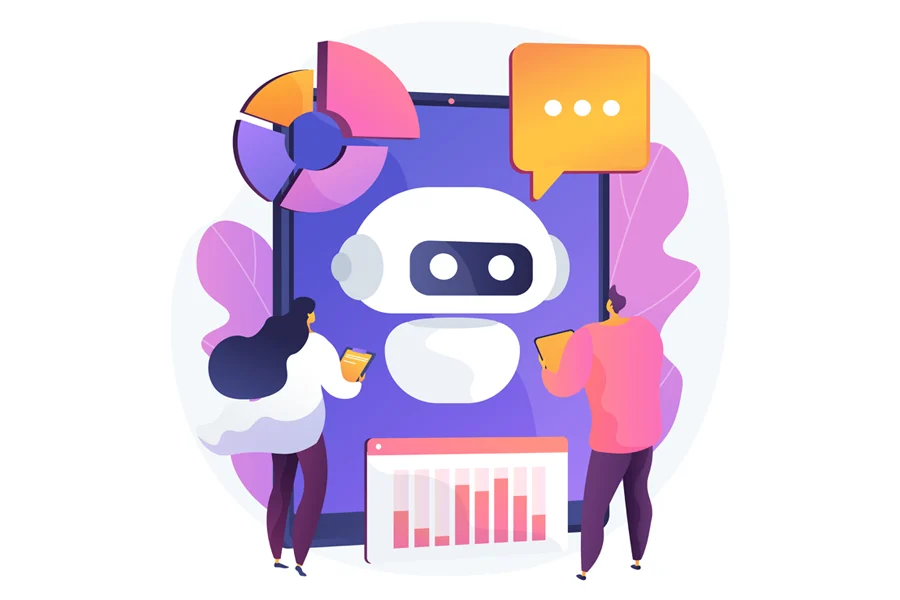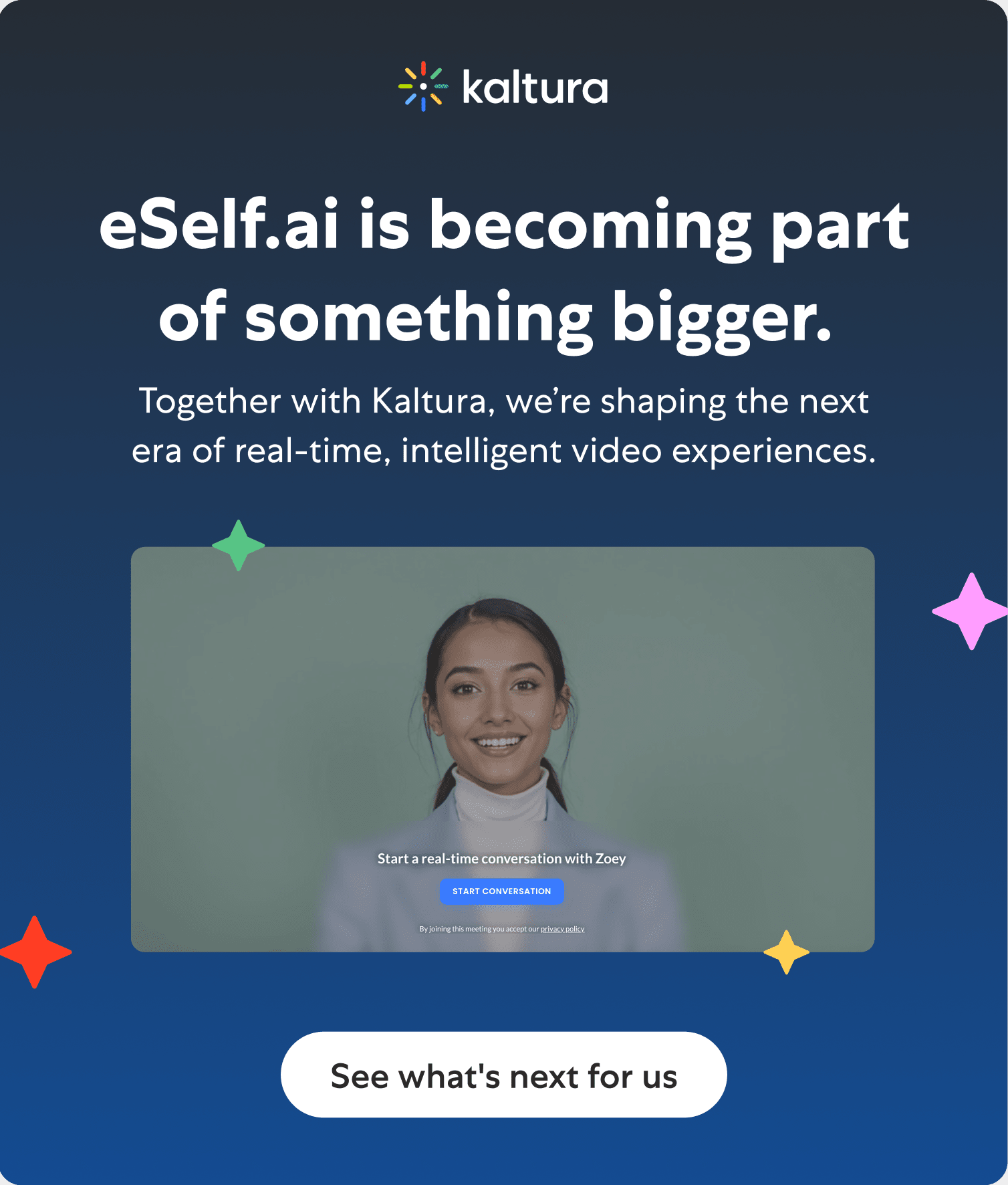Conversational AI is transforming how businesses interact with customers, employees, and partners. From smarter customer support to AI sales assistants, organizations across industries are tapping into AI-driven conversations to improve experiences, reduce costs, and stay competitive.
In this article, we’ll dive into how conversational AI works, how to build a conversational AI strategy, real-world use cases, and future trends shaping this space.
What is Conversational AI?
Conversational AI refers to technologies that enable machines to engage in human-like dialogue. Using natural language processing (NLP), machine learning, and sometimes generative AI, conversational AI systems can understand, process, and respond to human language — whether through text or voice.
Main Purpose: The goal of conversational AI is to make talking to businesses online feel just like talking to a real person — smooth, quick, and helpful.
Chatbot vs Conversational AI:
- Chatbot: Typically follows scripted rules or decision trees. It can answer simple FAQs but struggles with complex queries.
- Conversational AI: Goes beyond scripts by understanding context, intent, emotions, and providing dynamic, intelligent responses. AI chatbots can handle nuanced conversations and even learn from new inputs over time.
Main Components of Conversational AI
- Natural Language Processing (NLP) – It figures out what the customer is trying to say.
- Machine Learning Models – It learns from interactions to improve over time.
- Dialog Management System – It remembers what you were talking about to keep the chat flowing naturally.
- Speech Recognition (for voice bots) – Converts spoken words into text.
- Text-to-Speech Systems (for voice bots) – Converts AI-generated responses into spoken words.
- APIs and Integrations – Connect AI with CRM, databases, and other systems.
How Does Conversational AI Work?
Conversational AI processes user input (text or speech), identifies intent, pulls relevant information from databases or predefined knowledge, formulates a meaningful response, and delivers it — all in real time. It continuously learns from every interaction, improving accuracy and personalization.
How Does Conversational AI Work for Business?
For businesses, conversational AI acts like an extra team member that’s always available. It can answer customer questions, help with sales, solve problems, book appointments, and even collect important data — all without needing a human agent for every interaction.
This means faster service, lower support costs, happier customers, and the ability to serve many people at the same time — even across different time zones and languages.
In short, conversational AI helps businesses work smarter, save money, and grow faster by improving how they communicate with customers.
Benefits of Conversational AI for Your Business
Implementing conversational AI is not just about tech adoption — it’s a strategic investment that pays off across multiple fronts:
- Lower Customer Service Cost: Handle more inquiries with fewer human agents.
- Increase Customer Satisfaction: Quick, consistent, and helpful responses improve loyalty.
- Contactless Customer Service: Particularly critical post-pandemic for remote and safe interactions.
- 24/7 Availability and Scalability: Serve customers anytime, anywhere, without adding headcount.
- Increase Agent Efficiency: AI handles repetitive tasks, allowing agents to focus on complex cases.
- Unmatched Customer Service: Personalization at scale that human-only teams can’t match.
- Better Data Collection: Every interaction provides insights into customer needs and preferences.
- Easy Scalability: AI can handle 10,000 users as easily as it handles 10 — perfect for growing businesses.
Types of Conversational AI
- Traditional Chatbots – Rule-based, scripted bots.
- AI-Powered Chatbots – Context-aware bots using machine learning.
- Generative AI Chatbots – AI that creates dynamic, human-like conversations (e.g., ChatGPT).
- AI Agents – Advanced bots capable of task execution (like booking a ticket or completing transactions).
- Voice Assistants – Siri, Alexa, Google Assistant-like systems.
- AI Copilots / Embedded Conversational Assistants – AI embedded into apps (like Notion AI or GitHub Copilot).
- Multimodal Interfaces – Bots that combine voice, text, and visual elements.
Conversational AI Use Cases Across Industries and Real-World Examples

Conversational AI isn’t just for customer support — it’s changing how entire industries work. Conversational AI use cases are everywhere today — across retail, banking, healthcare, education, and more. Let’s take a closer look at how different types of businesses are using conversational AI to grow faster, serve customers better, and save money.
Use Cases of Conversational AI in Retail
Retailers use conversational AI to help customers find products faster, recommend items based on preferences, and answer questions — without needing a salesperson. It boosts sales and improves customer satisfaction.
This helps boost sales, reduce shopping time, and make customers happier.
Real-World Example of Conversational AI in Retail:
H&M uses an AI chatbot to recommend clothes to customers based on their style preferences. Levi’s also uses AI to help online shoppers find the perfect pair of jeans, which increased their online sales and reduced product returns.
Use Cases of Conversational AI in Banking
Banks are using conversational AI to transform the way they interact with customers. Conversational AI for banks helps provide faster service, better security, and personalized financial guidance.
Banks use AI chatbots and voice bots to help customers check account balances, make transactions, or answer financial questions securely — without waiting in line or calling customer service.
This saves customers time, makes banking more convenient, and lowers support costs for banks.
Real-World Example of Conversational AI in Banking:
Wells Fargo introduced a voice assistant that lets customers access their account information securely through mobile banking. Upstart uses conversational AI to help people prequalify for loans easily online, making the lending process faster and more accessible.
Use Cases of Conversational AI in Healthcare
Healthcare providers use conversational AI to help with early diagnosis, mental health support, appointment scheduling, and answering basic health questions — improving patient care and reducing wait times.
This helps reduce wait times, free up doctors’ time, and improve patient care.
Real-World Example of Conversational AI in Healthcare:
Babylon Health and Ada Health use AI-powered bots to ask patients about their symptoms and suggest whether they should see a doctor. Woebot is an AI chatbot that offers mental health support through friendly conversations, helping people manage stress and anxiety.
Use Cases of Conversational AI in E-commerce
Online shops use conversational AI to assist customers with finding products, tracking orders, solving issues, and offering multilingual support to global shoppers.
It helps increase sales, improve global reach, and lower customer service costs.
Real-World Example of Conversational AI in E-commerce:
Shopify powers online stores with multilingual customer support bots, helping merchants reach customers around the world and improve customer satisfaction rates.
Use Cases of Conversational AI in HR & Recruitment
Companies use AI to screen job applicants faster, answer candidate questions, and schedule interviews — saving time and improving the hiring process.
Conversational AI saves HR teams a lot of time, reduces hiring costs, and improves the candidate experience.
Real-World Example of Conversational AI in HR & Recruitment:
Paradox’s Olivia bot automatically pre-screens candidates, answers job applicants’ questions, and even schedules interviews, helping companies hire faster and reduce recruitment costs.
Use Cases of Conversational AI in Travel
Travel companies use conversational AI to book trips, suggest travel packages, assist with itinerary planning, and support travelers in airports.
This makes traveling easier, reduces service lines, and improves overall customer satisfaction.
Real-World Example of Conversational AI in Travel:
Expedia uses AI travel assistants to help customers plan and book their trips. Singapore Changi Airport introduced concierge bots that help travelers find gates, restaurants, and airport services quickly.
Use Cases of Conversational AI in Telecom & Utilities
Telecom providers use AI to let customers change service plans, troubleshoot problems, or pay bills — all without speaking to a human agent. This saves companies support costs and gives customers faster answers.
Real-World Example of Conversational AI in Telecom & Utilities:
Verizon and AT&T use conversational AI for self-service troubleshooting, making it easier for customers to solve issues like phone setup or internet outages without long waits.
Use Cases of Conversational AI in SaaS (Software Companies)
Software companies embed conversational AI inside their apps to help users onboard faster, answer common questions, or suggest how to use features better.
This boosts user satisfaction, reduces support ticket volume, and increases product usage.
Real-World Example of Conversational AI in SaaS:
HubSpot uses AI to guide new users through setting up accounts and using their marketing tools.
These conversational AI examples show it’s helping businesses work smarter and deliver better service — whether it’s retail, healthcare, finance, or education.
Conversational AI is helping businesses in every industry work smarter, faster, and better. Whether it’s helping customers shop, guiding students, supporting patients, or assisting employees — conversational AI is quickly becoming a must-have tool for companies that want to stay ahead.
Step-by-Step Guide on How to Build a Conversational AI Strategy
Building a conversational AI strategy that actually helps your business isn’t about throwing a chatbot on your website and hoping for the best. It takes a smart, thoughtful plan.
Here’s a simple step-by-step guide to help you build a strong conversational AI strategy from the very beginning — one that truly supports your goals and creates a great experience for your users.
Step 1 – Define Your Business Goals
Before you even think about the technology, you need to be clear on what you want to achieve.
Ask yourself:
- Are you trying to lower customer service costs?
- Do you want to increase sales?
- Is the goal to improve customer satisfaction or speed up processes?
Knowing your goals will shape everything that comes next. Without clear goals, your AI project could easily miss the mark.
Step 2 – Identify Target Users and Use Cases
Next, figure out who will be using your AI and what you want it to do.
Ask:
- Are you targeting customers, employees, or both?
- What are the most common questions or problems they have?
- Where can an AI really make things easier?
Start with simple use cases (like answering FAQs or helping with order tracking) and expand over time.
Step 3 – Choose the Right Channels
Where should your users be able to talk to your AI?
You need to pick the right communication channels based on where your audience already is:
- Website chat widgets.
- Mobile apps.
- Messaging apps like WhatsApp or Facebook Messenger.
- Voice assistants.
The easier it is for people to reach your AI, the more valuable it becomes.
Step 4 – Design the Conversational Experience
This step is all about creating conversations that feel natural and helpful — not robotic or frustrating.
Tips for designing a good experience:
- Use friendly, easy-to-understand language.
- Guide users clearly through what the AI can (and can’t) do.
- Plan for what happens when the AI doesn’t understand — and make sure it offers to connect to a human agent if needed.
Good conversation design builds trust and keeps people coming back.
Step 5 – Select the Right Technology and Platform
Now it’s time to choose the tools that will power your AI.
Look for a platform that:
- Matches your business needs.
- Can grow with you.
- Works with your existing tools (like CRM, help desks, e-commerce platforms).
- Is easy enough for your team to update and manage.
You don’t always need to build from scratch — many great platforms offer plug-and-play options.
Step 6 – Integrate with Existing Systems
To make your AI really useful, it needs to connect with the systems you already use.
For example:
- Pulling order info from your e-commerce system.
- Checking customer profiles from your CRM.
- Creating support tickets in your helpdesk.
The more your AI can access real data, the more helpful and powerful it will be.
Step 7 – Train and Test Your AI
Before going live, you need to train your AI with real examples of the kinds of conversations it will have.
- Teach it how people ask questions in real life (not just textbook language).
- Test different scenarios — easy ones and complicated ones.
- Make sure it knows when to ask for help or transfer the user to a person.
The better the training, the better your AI will perform from day one.
Step 8 – Launch, Monitor, and Optimize
Finally, it’s time to go live — but your work doesn’t end there!
After launching:
- Monitor how conversations are going.
- Look for areas where the AI struggles or users get stuck.
- Collect feedback from users and your team.
- Keep training and updating your AI to get smarter over time.
A successful conversational AI strategy is never “set it and forget it” — it’s a continuous improvement process.
Following these steps ensures you create a conversational AI strategy that drives real results.
How to Measure the Success of a Conversational AI Strategy
Launching conversational AI is just the beginning — you need to check if it’s really helping your business and your customers.
Here are the key ways to measure its success:
1. Customer Satisfaction (CSAT): Ask users if they were happy with their experience. High scores mean your AI is doing its job.
2. Resolution Rate Without Human Help: Track how many issues the AI solves by itself. A higher rate = greater efficiency.
3. Average Handling Time (AHT): See if conversations are getting shorter. Faster help makes customers happier.
4. Cost Savings: Compare your customer service costs before and after using AI. Saving money means the AI is paying off.
5. User Engagement: Measure how many people interact with your AI and if they come back again. High engagement means trust.
6. Conversion Rates or Sales Impact: If AI is helping sales, track how many users complete purchases or sign-ups after chatting.
7. Error Rate and Feedback: Keep an eye on wrong answers or frustrated users. Fewer mistakes = better AI performance.
Consistently measuring these KPIs helps you improve and implement a conversational AI strategy that keeps delivering better results.
Common Challenges of Conversational AI and How to Overcome Them
Conversational AI can be powerful, but it also comes with challenges.
Here are the most common issues — and how you can fix them:
- Privacy Issues: AI handles sensitive information. Follow privacy laws, encrypt data, and be transparent with users.
- Bad Training Data: Limited examples make AI less accurate. Train your AI with real, diverse conversations — and keep updating it.
- Tough Integrations: Connecting AI to your systems isn’t always easy. Choose platforms with flexible integrations and build step-by-step.
- Unrealistic Expectations: Remember — AI is smart, but not magic. Set clear, realistic goals and plan for ongoing improvements.
- Customer Frustration: AI mistakes can annoy users. Always offer an easy way to talk to a real person if needed.
- Language and Cultural Differences: One-size-fits-all AI doesn’t work globally Adapt your AI to support multiple languages and cultures.
By following conversational AI best practices, like securing data, training AI well, and planning for human backup, you can overcome these hurdles smoothly.
Future Trends of Conversational AI
The future of conversational AI is defined by several important trends.
More personalization will allow AI systems to better understand individual user preferences and deliver tailored interactions.
Voice and text together will become standard, enabling users to seamlessly talk, type, or share images during conversations.
Emotionally smarter AI will emerge, with bots able to detect emotions such as happiness, frustration, or sadness and respond appropriately.
Voice shopping will grow in popularity, making it as common and natural as sending a text message.
The development of self-upgrading AI will enable systems to continuously improve their own capabilities without manual updates.
Finally, the focus will shift toward helping humans, not replacing them, as conversational AI increasingly acts as a tool to support employees rather than replace their roles.
Improve Your Customer Experience With Conversational AI
Using conversational AI isn’t just a cool trend — it’s a smarter way to connect with your customers. Businesses that start now will have a big advantage: faster service, happier customers, and lower costs. Whether you’re a big company or a small one, there’s a conversational AI solution that fits your needs.
FAQs About Conversational AI Strategy
How to Choose the Right Conversational AI Platform?
Look for one that’s easy to set up, connects with your tools, and grows with your business.
Where Conversational AI Is Used?
In online shopping, banks, schools, apps, hospitals — pretty much everywhere people need quick help.
Which is the best conversational AI?
There’s no one “best.” It depends on your business. Some big names are OpenAI, Google, IBM, and Microsoft.
What are some examples of conversational AI?
Siri, Alexa, Duolingo’s AI tutor, and customer service chatbots are good examples of conversational AI.
Why is a Conversational AI strategy important for business?
It helps businesses talk to customers better, faster, and cheaper — while improving the overall experience.
What are the most common use cases for Conversational AI?
Answering questions, helping people shop, fixing problems, booking appointments, or supporting employees.
Can small businesses use a Conversational AI strategy effectively?
Absolutely! Even small businesses can use simple AI chatbots to save time and offer better service.
What industries benefit most from Conversational AI?
Retail, banking, healthcare, education, travel, software companies, and more.


